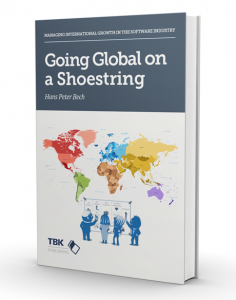Growth Through Global Expansion – a Must Rather than an Option
 “Going Global on a Shoestring” is the title of the book that I will release in the 1st half of 2018 (it was originally planned for Q4 2017, but plans have changed).
“Going Global on a Shoestring” is the title of the book that I will release in the 1st half of 2018 (it was originally planned for Q4 2017, but plans have changed).
I am writing the book for software companies that have a value proposition which is attractive to customers all over the world and for software entrepreneurs that have ambitions for getting the most value out of their business, while they can.
Why focus on the software industry?
I have worked in this industry for over thirty-five years. It is my industry. But also because rapid globalization is the only strategy option for survival in the software industry. You either grow fast globally, or you die slowly locally.
Why is that so?
- The marginal cost of producing an additional license or adding a user or an account to your SaaS solution is small and decreasing. The market leader will enjoy massive financial advantages over their smaller competitors. Economic benefits get translated into more marketing and better products.
- There may be a need for some level of localization and translation, but in general, software travels easily across borders. The complementary professional services required to deliver the ultimate value for the customers do not cross borders so easily, but as soon as a service delivery capability is established customer resistance against foreign products will normally evaporate.
- The law of diffusion of innovation will attract main stream customers to the global market leader(s). It means that the faster you become a global market leader, the faster your customer acquisition cost will decline to leave you with steadily increasing margins that can reinforce your competitive position and strengthen your global expansion.
- Software companies from small countries have domestic markets that are too small to allow for the critical mass required to compete effectively with insurgents from the larger markets, specifically companies originating in the USA and in China.
- The barriers to entry for new software companies are low and decreasing. No company can rest on their laurels for long, and the only effective weapon against insurgents is global brand recognition and market leadership.
- It becomes steadily easier to start a software company, but making it into a successful business becomes steadily more challenging. In the future, there will be no place for small local software companies unless they are on the fast track to global market leadership.
Domestic market leadership is not enough
 Imagine you own a software company operating only in Switzerland. With a 38% market share, annual revenue of 50 million Euro and a profit margin of 17% you think you are doing well.
Imagine you own a software company operating only in Switzerland. With a 38% market share, annual revenue of 50 million Euro and a profit margin of 17% you think you are doing well.
A foreign competitor with 1 billion Euro revenue and a 25% profit margin decides to enter your market. They allocate 25 million Euro to the effort and start promoting their solutions, talking to your customers and business partners and recruiting your people. Due to their global presence they already enjoy some awareness in your market, and after six months you start losing deals to them. They may not succeed in taking your leadership position, but they will make your life miserable, and you have nowhere to go for additional funds to defend your home turf.
Do we care from where software comes?
 Take a look at the inventory of the software you use privately and for business purposes. Do you know where it comes from? Do you care where it comes from? I do not think you overly care as long as it delivers the value at an attractive price/performance ratio.
Take a look at the inventory of the software you use privately and for business purposes. Do you know where it comes from? Do you care where it comes from? I do not think you overly care as long as it delivers the value at an attractive price/performance ratio.
Example: Just recently we decided to find an alternative to MailChimp for submitting our bi-weekly to its more than 20,000 subscribers. We ended up choosing MailerLite. Only much later did we find out that MailerLite is a Lithuanian company. Is that an issue? Not at all.
I need case stories for the book
Are you in the process of expanding your software business globally and would you like to share your story with me (and the readers)?








